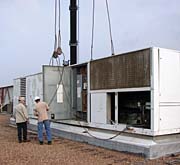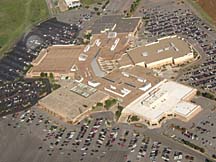Until last year, the mall still had its original thirteen 105-ton rooftop units, which were having trouble keeping up with the increasing heating and cooling demands of the mall. In addition, the maintenance and operating costs for the rooftop units kept climbing higher and higher, leading the mall's senior HVAC technician, Mark Toomoth, to decide that it was time to replace them.
Several issues stood in his way, though. First, it would be too expensive to replace all the rooftops at one time. Second, the mall could not be shut down to replace the rooftops. Third, each rooftop unit sat on an 18-inch concrete curb, which would be difficult (and expensive) to replace or rebuild.
Fortunately, the right combination of manufacturer and installing contractor was found to solve these problems.

Curbing The Problem
The existing rooftop units were at the upper end of their useful lives, so compressor failures were starting to occur frequently. The cost of replacing all 13 units in one year would have been prohibitively expensive, so the mall and the installing contractor worked out a five-year plan to replace three or four of the units each year until the retrofit is completed.Finding a rooftop manufacturer that could accommodate the mall's existing curbs became a top priority. At a minimum, most manufacturers' units would require that a three- or four-foot curb adapter be built above the existing curb to accommodate new electrical and duct connections. That would be a problem, because the rooftop units would then be visible above the parapets, which were designed to hide them in the first place.
The added height would also make it impossible to access the units for routine service and maintenance without a ladder or a catwalk, both of which were unacceptable to mall management. Another option involved rebuilding the curbs to fit new units, but that would be prohibitively expensive.
Toomoth decided to contact the original rooftop manufacturer, McQuay, to find out if its current rooftops could be made to fit the existing curbs. He discovered that McQuay's factory-modular rooftop units could, indeed, be specified to fit the exact dimensions that were needed.
Installing contractor, Marc McCormick, president, Air Engineering, Oklahoma City, noted that this was terrific news because, "If we'd used anybody else's units, we would've been up there making some huge ductwork changes. These units are 40 feet long, and the ductwork on them is probably 120 inches by 48 inches."
Since the new units had to be installed while the mall was closed, a quick setup was necessary.

Let The Retrofit Begin
The first three rooftop units were replaced in spring 2003. McCormick and his crew showed up at first light on a Sunday morning to remove the existing units and replace them with the new units. The equipment needed to be installed and operational by the time the mall opened at 11:00 a.m.Removing the old units became a bit of a challenge, in part because the rooftops had been sitting on their curbs for 23 years. The equipment couldn't simply be lifted off with a crane because there was a possibility that part of the roof could be ripped off with the unit.
"We had to remove all the flashing and separate the units," said McCormick. "Then we eased them up with the crane, working the units very carefully to make sure they did not rip the curb up."
The units that came off the roof weighed about 22,000 pounds each. Removing them was such a big endeavor that the largest hydraulic crane in the state was brought in to remove the old equipment and place the new units on the roof.
The crane was so big it took over two hours just to put it together. McCormick noted that when he installs the next set of rooftop units, he plans to set up the crane the night before.
Once the old equipment was removed, things went a little easier. The biggest issue then became the time constraints facing McCormick and his crew.
"We couldn't work at night, because we couldn't lift in the dark," McCormick said. "Given the size of the units, it wasn't easy to pick and place three units in four hours. We had about 20 guys running around on the roof, so it was a very busy morning."
The new rooftops were in-stalled and operational by the time the mall opened. The new units, which are ASHRAE 90.1-2001 compliant, feature a blow-through system design, which requires less conditioned air than draw-through designs to meet the same cooling load.
The controls are designed to interface with any open standard protocol (in this case, BACnet).
The new rooftop units have been running well, and McCormick is gearing up for the next installation. "Maybe we'll start an hour or so earlier in the morning, which will give us some much-needed extra time," he said.
Publication date: 06/14/2004


Report Abusive Comment